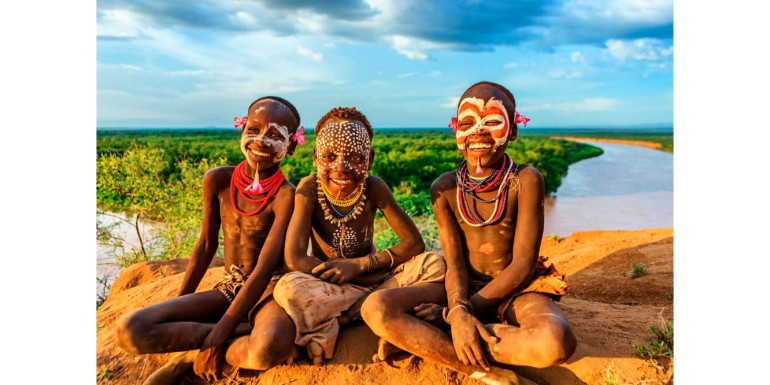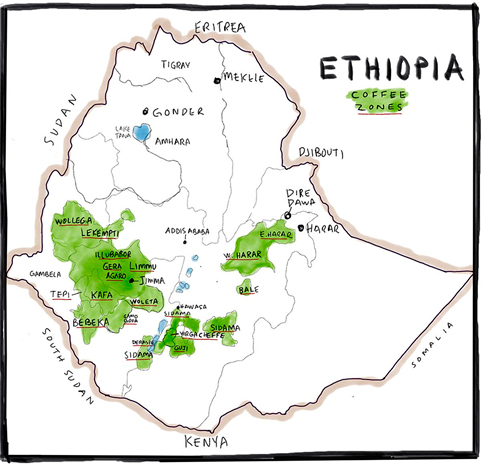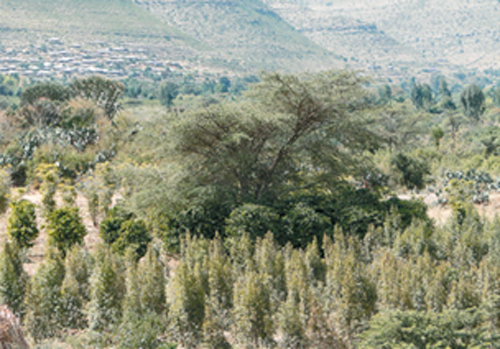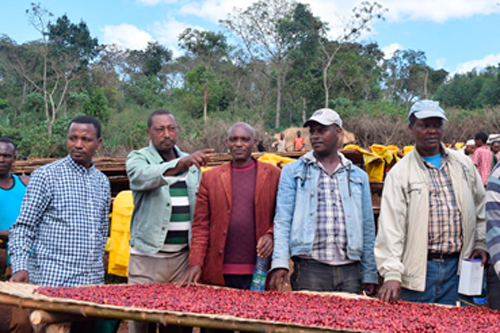Safari through Ethiopia, a jewel called "Heirloom"

THE JOURNEY BEGINS:
Dear clients and friends of cafés caracas,
We have the pleasure of presenting you a project that had us excited for a long time. This is our humble tribute to Ethiopian coffee, the place where the Arabica coffee bush originates from and, without a doubt, the most fascinating destination to go on a "safari" for the most authentic sensations that the world of coffee offers us.< /p>
Go ahead, Ethiopia is a very large country, larger than Spain and France combined, and despite being the fifth largest coffee-producing country in the world, it has many limitations of all kinds. As far as coffee is concerned: there is a lack of technology, logistics are complicated, traceability (at the varietal and farm level) is practically impossible, the drought is causing more and more havoc, investments are derisory and a long etcetera... but it has a something that makes it unique in the world: it is the cradle of coffee. This is a land and culture rooted in coffee for millennia, and it shows in many ways.
The coffee-growing areas of the country are high-altitude territories (1,300 meters on average), with dense vegetation, a hot and humid climate, and extremely fertile volcanic soil. The arabica coffee bush grows here spontaneously, like another plant in the forest. It grows at almost impossible altitudes (more than 2,200 meters) and the number of varieties of coffee plants is directly “uncatalogueable”. In fact... new varieties don't stop being generated naturally!
It is estimated that, in Ethiopia alone, there are more than 13,000 varieties of coffee. To make life a little easier for us, which is sometimes not bad at all, the coffee world calls all these native varieties so genuine: “heirloom”, and if you want to know more, we are going to dedicate a section to it. later, but stay with the idea that they are "a natural treasure" of Ethiopia.
For Ethiopians, coffee is an authentic ritual and has a privileged place within their culture. To say “socialize”, they use the words “buna tetu”, which would be equivalent to “drink coffee”. If you are invited to a coffee, you better not be in a hurry, since, following the ancestral tradition, they take about 45 minutes to prepare it: first they roast the green beans in a pan, once toasted they crush them with a mortar, and finally they infuse in a teapot…. and so much preparation, as expected, deserves a leisurely and patient consumption.
So our goal with this little (but fascinating) imaginary journey is to get you a little closer to the most authentic coffee there is. For this we have chosen four of the most representative coffee areas, with their most characteristic processes, which will surely make you enjoy an authentic safari of coffee sensations: Sidama , Kambata , Harar and Yrgacheffe. Do you sign up? Grab your bags, we're leaving!
SAFARI THROUGH THE GREAT CAFEES OF ETHIOPIA:
For this journey we will need a little imagination, since Ethiopia has an endless variety of coffee varietals, producing regions, microclimates, etc… in such a way that it makes it almost impossible to classify coffee according to its origin. In any case, we will try to simplify reality a bit in order to get closer to the profiles of some of its most recognized coffees.

STAGE 1: SIDAMA
We begin in the Sidama area, in the center-south area of the country. This coffee is an old acquaintance, as it is one of the highlights of our current range.
Sidama is a large expanse of land and a true coffee paradise (it is responsible for more than 45% of the coffee produced in the country). Its inhabitants are Christian-Orthodox, dominated by the Sidama (which give the region its name) and Oromo tribes. The language spoken is Amharic and Sidamaya.
This is a very humid area, with lush green landscapes. It is extremely mountainous, with a large number of rivers, high altitude mountains, highly fertile volcanic soils and a multitude of microclimates. This wonder of nature is located in the famous Rift Valley, which begins in this area and extends to southern Kenya, giving rise to this magical place where some of the best coffee in the world is found.
Contrary to what one might think, it is a highly populated area, where in turn land ownership is widely distributed, since it has been passed from generation to generation, having to divide the land into more and more parts as that had to be distributed among more members. Thus, these are very small producers (some of them do not produce more than 10 kilos of green coffee!), with highly differentiated crops (that is, they do not only grow coffee) in order to minimize the risks of possible bad harvest, disease or fluctuations in the price of coffee. As a consequence, coffee grows freely in quite dense forests, coexisting with other trees with great foliage and height, and this circumstance, together with the privileged enclave where it is located, makes coffee grow in the shade, thus reducing the sun exposure of grains and having a slower maturation. Likewise, the high altitude of the land (coffee is grown between 1,500-2,200 meters) and the incredible genetic superiority of the plants make its beans especially appreciated.
On the other hand, this diversity of producers and varieties of coffee plantations makes it very difficult to trace the product or define a very characteristic organoleptic profile. In general, it can be said that we are talking about blends of the best coffees in the world, and that they are characterized, in the case of those that are processed by the washed method, as coffees with great complexity of flavors (citrus, floral, spices). , fruit of the mixtures of the different varieties that are produced in the area, fresh and vibrant high acidity, with balanced sweetness.
STAGE 2: KAMBATA
From here we head east, towards Jimma, where the main coffee study center in Ethiopia is located. But a little before arriving we stopped in the Kembata-tembaro region, belonging to what is known as "the Region of Nations, Nationalities and Peoples of the South", it is one of the 9 federated states of Ethiopia, populated by the Kambaata ethnic group.
The Kambaata have their own language and centuries-old culture. It is a purely agricultural people living in (and from the countryside). The population density is even higher than at the previous stop, since birth records are broken here. The large number of children per family further accentuates the problem of family micro plantations, so that families do everything possible so that their crops (tubers, spices... and coffee) are of the highest quality.
The coffees in this area are naturally processed, unlike the previous region, which were washed. The natural process begins with washing, in this case at the Batalu Barar station, but later the beans are left to ferment for 36-48 hours. This causes the remains of coffee pulp to permeate the grain, so that more vivid and complex flavors are achieved, with brilliant acidity. Subsequently, the grains are left to rest on what is known as "Ethiopian bed", so that they can dry in the sun until they reach the optimum moisture level. This process takes about 21 days.
Take out your cameras, here comes the interesting thing: we are not going to discuss which is better, natural or washed coffees, on this trip you will be able to try two of each to reach your own conclusions, but we are going to insist that you try this coffee, which has everything you could ask for in a natural heirloom coffee of the highest quality. The intensity and personality that it gives off is surprising, an authentic find that provides a unique experience in a cup. They can't miss it!
This is a coffee grown at high altitude, about 1880 meters, with an intense flavor of red fruits, citrus... and all this accompanied by a great sweetness, with a very pleasant acidity and body. Without a doubt, the surprise of the trip.
STAGE 3: HARAR
We move northeast into the Oromia region (formerly Harrar). It is a very different part of Ethiopia from what we have seen so far: It is a very extensive territory, with a hot and dry climate, surrounded by large deserts, which reach the neighboring country of Somalia. Of Muslim religion, Arabic is spoken mainly and its populations are populated with a large number of mosques.
Coffee here is grown only in very specific areas, known as East Harar, West Harar and Bale. Its height is between 1400 and 2000 meters. Its sunnier and drier climate, together with the fact that it is an autochthonous shrub that stands out from the surrounding vegetation, means that the grains are more exposed to the sun in an extremely strong plant that is perfectly adapted to its environment... the result: a coffee with great personality and intensity in the cup.

In the case of Harar, the coffees we find have a strong wild and exotic character. These are powerful coffees whose flavor “resonates” in the cup. They have a characteristic dry, fruity flavor (often compared to dry red wine) and interesting dark chocolate notes (especially if they come from the Bale region). Its main characteristic is its complex flavor of wild fruits (blueberries, blackberries and apricots), its creamy body, with a pleasant and slightly fermented aftertaste.
In this area the processing is typically natural (as was the case with the Kambata) which gives it, if possible, even greater character and intensity in the cup.
A curiosity: in the area of East Harar there are so-called "Golden Beans". They occur naturally on some shrubs with no apparent explanation. They are highly appreciated for the intense blueberry flavor that they process in the cup.
STAGE 4: YRGACHEFFE
We have turned around a bit because we wanted to leave the most typical for last…. last stop: Yrgacheffe. Going to Sidama and not visiting Yrgacheffe is like going to Paris and not seeing the Eiffel Tower!
Yrgacheffe is a small town within the Sidama region. It has only about 20,000 inhabitants, but it is a true metropolis in the world of coffee. Its coffees are one of the few with designation of origin in Ethiopia... an exceptional coffee with a well-deserved fame that precedes it worldwide. Much of the coffee produced here is from the washed process, as is our case.
Fruity flavors, bright acidity, silky body. Slight grassy notes for washed coffees. It is a genetically superior coffee, considered one of the best in the world. It is grown at altitudes between 1,600 and 2,400 meters, and in the cup sweet flavors stand out, aromas of flowers (jasmine), fine acidity and good body.
Characteristics may vary depending on low and high areas; For example, a coffee produced at an altitude of 1,600-1,800 meters in the Chichu and Michle cooperatives has herbaceous notes in its aroma. However, a coffee produced at an altitude of 2,000-2,400 meters, as is the case, exudes a floral aroma.
END OF THE JOURNEY…OR NOT?
This trip to Ethiopia ends here, with the feeling that we have seen extraordinary things, but above all with the desire to know much more, and luckily... there is much more! We still have the entire western part of the country, with mythical coffees such as Limmu (markedly spicy, sweet and floral) and Jimma (also spelled Djimma), just to name a few... without forgetting Guji or Gedeo. But this is part of another trip… We hope you enjoyed this safari as much as we did!
And what is promised is debt... What is Heirloom?
HEIRLOOM: THE FAMILY ANCESTRAL TREASURE
As we indicated at the beginning, Ethiopia is not only the cradle of coffee, but it is also a true paradise. The coffee plantations grow here spontaneously, crossing naturally with other varieties, or simply adapting to their environment, thus creating new varieties. The result: there are so many varieties, an estimated 13,000, and they are so difficult to classify that to simplify our lives we use the term heirloom.
And what does it mean? Well, in the language of Shakespeare, heirloom would come to be translated as something old, of great value, that belongs to the family. Something like a family heirloom, that great-great-grandparents tableware that, due to its authenticity and emotional attachment, is given incalculable value.
In the case of coffee, heirloom refers to an old variety, some indicate that it must be at least more than 100 years old to be considered as such. It is used to refer to the old varieties of Arabica coffee that were originally introduced to Latin America and Asia from Ethiopia.
And from here, everything enters: there are more floral, sweeter, acidic or fruity ones, but in general, due to the fact of having this name, they are considered coffees of the highest quality, complex, autochthonous and wild (and therefore usually organic). That being said, under this great umbrella there are real rarities... exciting pleasures for the senses waiting to be discovered.
It is a term that says it all, and at the same time it says nothing, since it groups such a number of varieties that it is impossible to define a single profile. Some think that the use of this term does not favor local plantations, since since they do not disclose their specific varieties and, since everything ends "in the same bag", local farmers are denied the possibility of being able to give know their specific benefits, thus denying them the possibility of building a prestige for the final consumer and thus being able to obtain higher income.
On the other hand, imagine having to talk about 13,000 different varieties in Ethiopia alone, almost impossible to identify and catalog them! In addition, due to limitations of various kinds, its traceability is practically impossible.
Ethiopian specialty coffee buyers do distinguish coffee based on region, altitude, and cupping note, but not by variety.
So, stay with the idea that Heirloom is that heirloom of the coffee family, so precious, unique and unrepeatable, that it can only be found in Ethiopia... essential for those who like the authentic... even if it is not totally well labeled!

Recent posts
-
Rwanda Nyamasheke Coffee: Volcanic Sweetness in Your Cup 21/07/2025Colombian Coffee: Tabí del Cauca, a Cup of Excellence from the Inza Mountains 17/01/2025China's Treasure: Specialty Coffee from the Country of Tea 22/11/2024Christmas Coffee 2024 Panama Quetzal: the origin of a unique flavor 19/11/2024
Comments
Log in or register to post comments





